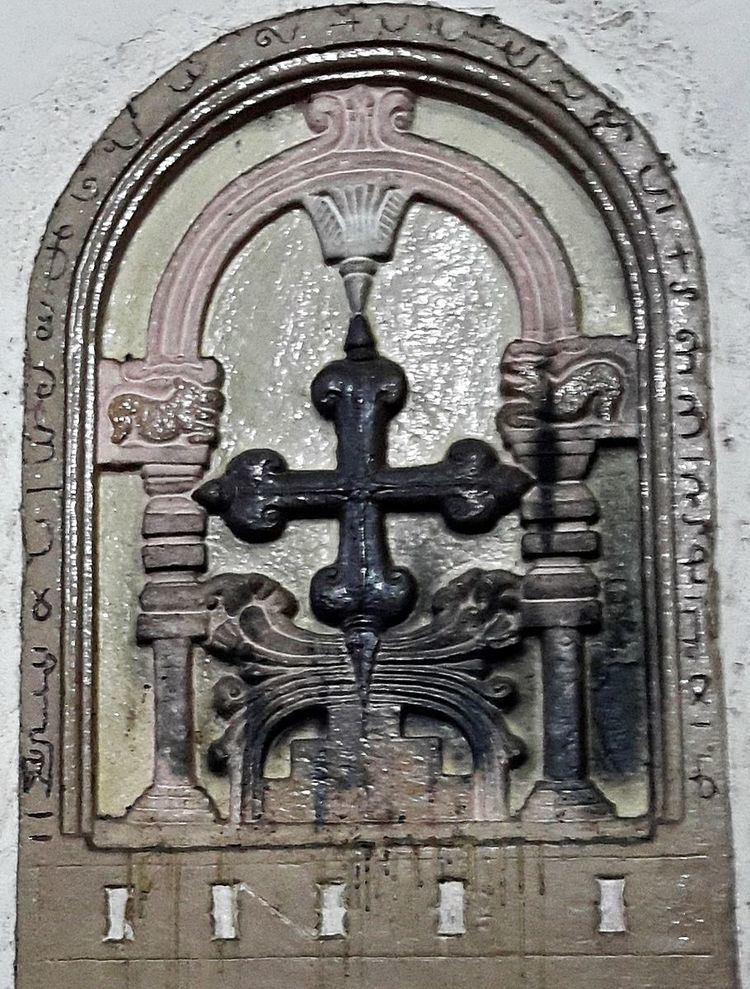 | ||
Saint Thomas Christian crosses are ancient crosses which belonged to the ancient community of Saint Thomas Christians of Indian sub continent who trace their origins to the evangelistic activity of Saint Thomas in the 1st century thus making it one of the oldest Christian communities of the world. Saint Thomas Christian crosses are broadly classified as Mar Thoma Sliba (Saint Thomas Cross), Persian Cross, and Nasrani Sthambam.
Contents
- Mar Thoma Sliba
- Locations of Mar Thoma Sliba
- Interpretation of the inscriptions
- Symbolism of Mar Thoma Sliva
- Persian Cross
- Nasrani Sthambam
- References
Mar Thoma Sliba are found at Kadamattom, Muttuchira, Kothanalloor, Kottayam and Alangad in the South Indian state of Kerala. Outside Kerala, they are found in Goa and Tamil Nadu in India, Anuradhapura in Sri Lanka and Taxila in Pakistan. Flowery Persian Crosses found at Kottakkavu, Pallipuram and Niranam. The large open air rock crosses known as Nasrani Sthambams are found at the frontage of many Saint Thomas Christian churches in Kerala. It is recorded that before the arrival of Portuguese explorers there were more than 150 Syrian churches in Kerala.
Mar Thoma Sliba
Mar Thoma Sliba is a Syriac term which means Saint Thomas Cross. Antonio Gouvea in the sixteenth century work, "Jornada" states that the old churches of Saint Thomas Christians were full of crosses of the type discovered from S. Thome (Mylapore). He also states that veneration of the cross is an old custom in Malabar. "Jornada" is the oldest known written document which calls the cross as St. Thomas Cross. The original word used is " Cruz de Sam Thome " meaning Cross of St. Thomas. Interestingly, Gouvea writes about the veneration of the Cross at Cranganore mentioning it as "Cross of Christians"
Locations of Mar Thoma Sliba
The crosses are at the following locations,
Interpretation of the inscriptions
Arthur Coke Burnell, archeologist, in 1873, translated the inscriptions as follows:
Prof. F. C. Burkitt and C. P. T. Winckworth, the then reader of Assyriology in the University of Cambridge studied the inscriptions and produced a translation. This has been discussed at the International Congress of Orientalists held at Oxford in 1925.
The interpretation is as follows:
On the large cross, there is this additional sentence in Estrangelo Syriac. (Galatians 6:14)
The inscription at Kadamattom church when translated is,
Symbolism of Mar Thoma Sliva
Unlike crosses in other traditions, the St. Thomas Cross does not carry the effigy of the Christ. In addition to this unique quality, each of its elements carry symbolic meanings. Generally the Cross symbolizes life rather than death and suffering.
Persian Cross
Kottakkavu Mar Thoma Syro-Malabar Pilgrim Church, North Paravur and St. Mary's Syro-Malabar Forane Church, Pallipuram under the Major Archeparchy of Ernakulam-Ankamaly of the Syro Malabar Church and St. Mary’s Orthodox Syrian Church, Niranam under the Niranam diocese of the Malankara Orthodox Syrian Church has ancient flowery Persian Cross.
Nasrani Sthambam
Nasrani Sthambams are giant open air stone crosses. The plinth of these crosses represents lotus petals and lotus flowers and has a square base. It also has a variety of iconographic motifs, including elephants, peacocks and various other animals to name a few. These crosses are found in Puthenchira, Parappukkara, Veliyanad, Kalpparambu, Angamaly, Kanjoor, Malayattoor, Udayamperoor, Kuravilangad, Uzhavoor, Chungam, Kaduthuruthy, Muthalakodam, Muttuchira, Kudamaloor, Niranam, Arakuzha, Kothamangalam, Chengannur, Thumpamon, Chathannur and many other places.
